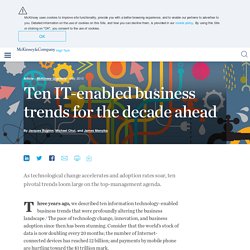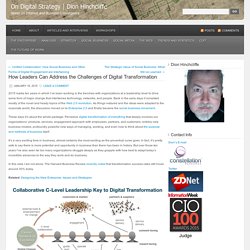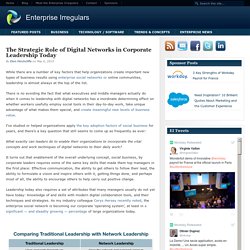

4364 Industry4 0 Are you ready Report. The Industry 4.0 manufacturing revolution. Deloitte and Forbes Insights would like to thank the following for sharing their time and expertise: Flemming Besenbacher, chairman of Carlsberg Natasha Buckley, senior manager, Deloitte Center for Integrated Research.

Ten IT-enabled business trends for the decade ahead. As technological change accelerates and adoption rates soar, ten pivotal trends loom large on the top-management agenda.

Three years ago, we described ten information technology–enabled business trends that were profoundly altering the business landscape. The pace of technology change, innovation, and business adoption since then has been stunning. Consider that the world’s stock of data is now doubling every 20 months; the number of Internet-connected devices has reached 12 billion; and payments by mobile phone are hurtling toward the $1 trillion mark. This progress both reflects the trends we described three years ago and is influencing their shape.
The article that follows updates our 2010 list. The dramatic pace at which two trends have been advancing is transforming them into 21st-century business “antes”: competitive necessities for most if not all companies. Implicit in our earlier work, and explicit in this update, is a focus on information and communication technologies. 1. 2.
How social business grew up. Who would have thought that social networks like Facebook, Twitter, and LinkedIn would ultimately end up having such a profound impact on the way we think about and run our businesses?

The story of this journey, called by many social business, revolves around the deep application to our organizations of the ideas that made social media such a potent and popular way of communicating globally. The imperative for doing so has become quite clear. According to recent estimates, by 2020 there will be over 7 billion people and businesses -- along with at least at least 30 billion devices -- all connected together digitally. In other words, most of the planet. Businesses not fully engaged with this most relevant marketplace will miss the larger opportunity. How Leaders Can Address the Challenges of Digital Transformation. 2015 marks ten years in which I’ve been working in the trenches with organizations at a leadership level to drive some form of major change that intertwines technology, networks, and people.

Back in the early days it consisted mostly of the novel and heady topics of the Web 2.0 revolution. As things matured and the ideas were adapted to the corporate world, the discussion moved on to Enterprise 2.0 and finally became the social business movement. These days it’s about the whole package: Pervasive digital transformation of everything that deeply involves our organizations’ products, services, engagement approach with employees, partners, and customers, entirely new business models, profoundly powerful new ways of managing, working, and even how to think about the purpose and methods of business itself. It’s a very exciting time in business, almost certainly the most exciting as the proverbial curse goes. The Strategic Role of Digital Networks in Corporate Leadership Today. While there are a number of key factors that help organizations create important new types of business results using enterprise social networks or online communities, leadership is almost always at the top of the list.

There is no avoiding the fact that what executives and middle managers actually do when it comes to leadership with digital networks has a inordinate determining effect on whether workers usefully employ social tools in their day-to-day work, take unique advantage of what makes them special, and create meaningful new levels of business value. I’ve studied or helped organizations apply the key adoption factors of social business for years, and there’s a key question that still seems to come up as frequently as ever: What exactly can leaders do to enable their organizations to incorporate the vital concepts and work techniques of digital networks to their daily work? Digital Networks: The New Management Imperative Create Reach: Cultivate Network Capital Additional Reading: In Digital Transformation, Culture Change Goes Hand in Hand with Tech Change.
I’ve spent a lot of time in the last few years identifying the best approaches for that urgent enterprise topic of our time, digital transformation.

When I first started, I often looked to top examples of organizations that have started the transition and made good progress (see sample case studies below.) More recently I’ve derived insights from my work directly with a number of organizations on their individual transformation journeys. Ultimately, however, I have determined that the short answer is one that you might expect: There is no single blueprint for transformation that works well for everyone. Instead, the right steps very much depend on the organization itself. We also know now that there are indeed common success factors we can apply, if we can adapt them to our organizations. The resulting adapted framework is informed by best practices and industry lessons learned so far.
The framework is balanced so it does not focus too much on technology or change management. Like this: Harvard's Chief Digital Officer: 10 Digital Best Practices. Having had many phenomenal CIO and CMO guests on our CXOTalk show, it was an absolute delight to welcome our first Chief Digital Officer (CDO) guest, Perry Hewitt of Harvard University.

In her role as CDO for the past 3 years, Hewitt is charged with Harvard University’s efforts to develop a comprehensive strategy for digital communications and engagement, as well as to establish best practices for content, multimedia and technology. How to revive a dying social media presence.